ERP software for cloud computing is revolutionizing the way businesses manage their operations, offering a comprehensive suite of tools and capabilities that streamline processes, enhance collaboration, and drive growth. This guide delves into the world of ERP software, exploring its key features, benefits, and considerations for successful implementation.
As businesses navigate the ever-evolving landscape of digital transformation, ERP software for cloud computing has emerged as a game-changer, empowering organizations to achieve greater agility, efficiency, and cost-effectiveness.
Overview of ERP Software for Cloud Computing
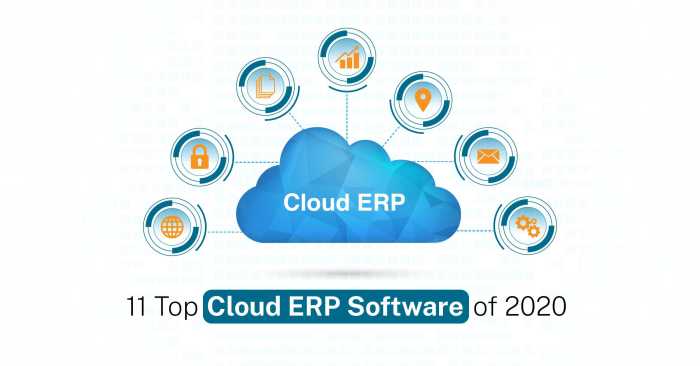
Enterprise Resource Planning (ERP) software is a comprehensive business management solution that integrates various aspects of an organization’s operations into a single, unified system. It provides real-time visibility into key business processes, enabling companies to improve efficiency, streamline operations, and make informed decisions.
Deploying ERP software in the cloud offers numerous advantages over traditional on-premises solutions. Cloud-based ERP systems eliminate the need for expensive hardware and software installations, reduce IT maintenance costs, and provide scalability to accommodate changing business needs.
Benefits of Cloud-Based ERP Software
- Reduced IT Costs:Cloud ERP eliminates the need for on-premises servers and IT infrastructure, significantly reducing hardware and software acquisition and maintenance costs.
- Increased Flexibility and Scalability:Cloud ERP allows businesses to easily scale their systems up or down as needed, accommodating fluctuations in demand and supporting growth without significant capital investment.
- Enhanced Data Security:Cloud ERP providers typically implement robust security measures to protect sensitive business data, ensuring compliance with industry regulations and minimizing the risk of data breaches.
- Improved Collaboration and Accessibility:Cloud ERP enables employees from different departments and locations to access and collaborate on real-time data, fostering better communication and decision-making.
li> Regular Updates and Enhancements:Cloud ERP providers regularly update and enhance their software, ensuring businesses have access to the latest features and functionality without the need for costly upgrades.
Conclusion
Cloud-based ERP software offers numerous benefits for businesses of all sizes, providing cost savings, increased flexibility, enhanced data security, improved collaboration, and ongoing access to the latest software updates. By leveraging the power of the cloud, organizations can streamline their operations, make better decisions, and gain a competitive edge in today’s dynamic business environment.
Key Features and Functionality
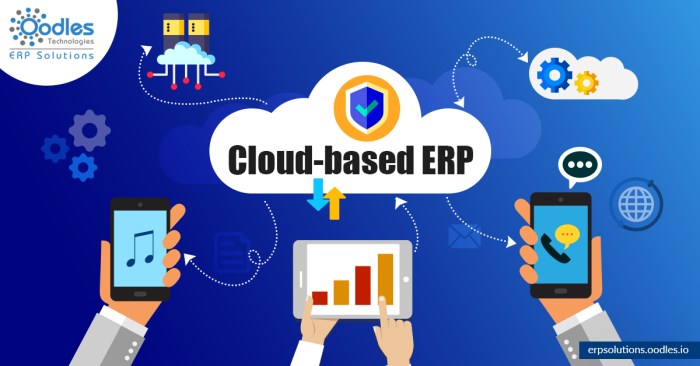
ERP software for cloud computing offers a comprehensive suite of features and functionalities that streamline and enhance business operations. These capabilities empower organizations to manage various aspects of their business from a centralized platform, fostering efficiency, collaboration, and data-driven decision-making.
The core modules of ERP software for cloud computing typically include:
Finance
- General ledger and financial reporting
- Accounts payable and receivable
- Cash management
- Budgeting and forecasting
Supply Chain Management
- Inventory management
- Order processing
- Warehouse management
- Transportation management
Human Resources
- Payroll processing
- Benefits administration
- Time and attendance tracking
- Employee self-service
Benefits of Using ERP Software for Cloud Computing
ERP software in the cloud offers significant advantages that can enhance business operations. By leveraging cloud-based infrastructure, organizations can realize substantial cost savings, improved efficiency and productivity, and enhanced collaboration and data sharing capabilities.
Cost-saving Benefits
One of the key benefits of cloud-based ERP is cost savings. Organizations can eliminate the need for expensive hardware and software purchases, as well as ongoing maintenance and support costs. Cloud providers offer flexible pricing models, allowing businesses to pay only for the resources they use, resulting in reduced IT expenses.
Additionally, cloud-based ERP eliminates the need for dedicated IT staff, further reducing operational costs.
Improved Efficiency and Productivity
Cloud-based ERP streamlines business processes, leading to improved efficiency and productivity. With real-time access to data and applications, employees can collaborate seamlessly and make informed decisions quickly. Automation features within ERP software reduce manual tasks, freeing up time for more strategic initiatives.
Additionally, cloud-based ERP provides a centralized platform for data storage and management, eliminating data silos and ensuring data integrity.
Enhanced Collaboration and Data Sharing
Cloud-based ERP facilitates collaboration and data sharing among employees, departments, and even external stakeholders. The centralized platform allows users to access and share data securely, regardless of their location. This enables seamless communication, improved decision-making, and better coordination of business activities.
Cloud-based ERP also supports role-based access controls, ensuring data security and privacy while fostering collaboration.
Implementation and Deployment Considerations
Implementing and deploying ERP software for cloud computing involves careful planning and execution. Here’s a step-by-step guide to ensure a smooth transition: Step 1: Assessment and PlanningConduct a thorough assessment of your business needs, processes, and IT infrastructure. Determine the specific modules and functionalities required from the ERP software.
Define clear implementation goals, timelines, and budget. Step 2: Data Migration and IntegrationData migration is crucial for a successful ERP implementation. Plan for data extraction, transformation, and loading into the new system. Ensure data integrity and accuracy throughout the process. Integrate the ERP system with existing applications and databases to ensure seamless data flow.
Step 3: Software Configuration and CustomizationConfigure the ERP software to align with your business processes and requirements. Customize the system to meet specific needs, such as industry-specific workflows or unique reporting requirements. Conduct thorough testing to ensure the system meets expectations. Step 4: User Training and AdoptionProvide comprehensive training to users on the new ERP system.
Encourage user adoption by involving them in the implementation process and addressing their concerns. Develop training materials and support mechanisms to ensure a smooth transition. Step 5: Deployment and Go-LiveDeploy the ERP software in a controlled environment and monitor its performance closely. Establish a rollback plan to mitigate any potential issues.
Communicate the go-live date to users and stakeholders and provide ongoing support during the transition. Best Practices for a Smooth Transition* Involve key stakeholders throughout the implementation process.
- Establish clear communication channels and regular progress updates.
- Use a phased approach to minimize disruption to business operations.
- Conduct thorough testing and quality assurance before go-live.
- Provide ongoing support and training to users after deployment.
Security and Compliance
ERP software for cloud computing must meet stringent security measures and compliance standards to ensure the confidentiality, integrity, and availability of data. Data encryption, access control, and disaster recovery are crucial elements of a secure ERP system.
Data Encryption
Data encryption is essential to protect sensitive data from unauthorized access. ERP software should use robust encryption algorithms to encrypt data both at rest and in transit. This prevents unauthorized individuals from accessing or modifying data even if they gain access to the system.
Access Control
Access control mechanisms limit who can access and modify data within the ERP system. ERP software should provide fine-grained access control, allowing administrators to define specific permissions for different users based on their roles and responsibilities. This ensures that only authorized individuals have access to the data they need to perform their jobs.
Disaster Recovery
Disaster recovery plans are essential to ensure business continuity in the event of a disaster. ERP software should provide robust disaster recovery capabilities, including data backup and recovery mechanisms. This ensures that data can be quickly restored and the system can be brought back online in a timely manner, minimizing business disruption.
Scalability and Flexibility
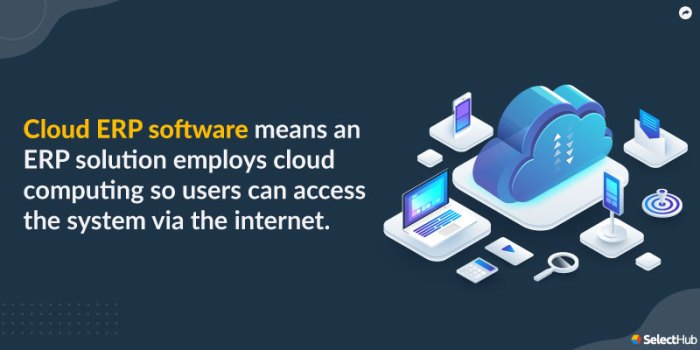
ERP software for cloud computing is designed to scale with the changing needs of businesses. As a business grows, its ERP system can be easily expanded to accommodate more users, data, and transactions. This scalability ensures that businesses can continue to use their ERP system as they grow, without having to invest in a new system.In addition to being scalable, ERP software for cloud computing is also flexible.
This means that it can be adapted to meet the specific needs of each business. Businesses can choose from a variety of modules and features to create an ERP system that is tailored to their unique requirements. This flexibility makes ERP software for cloud computing a valuable tool for businesses of all sizes and industries.
Benefits of Scalability and Flexibility
There are many benefits to using an ERP system that is scalable and flexible. These benefits include:
- Reduced costs: Scalable ERP systems can help businesses save money by eliminating the need to purchase and maintain multiple systems as the business grows.
- Improved efficiency: Flexible ERP systems can help businesses improve efficiency by streamlining processes and automating tasks.
- Increased agility: Scalable and flexible ERP systems can help businesses become more agile and responsive to change.
- Enhanced decision-making: Scalable and flexible ERP systems can provide businesses with the data and insights they need to make better decisions.
Integration with Other Systems
Integrating ERP software with other business systems is crucial for seamless data flow and efficient operations. It eliminates data silos, automates processes, and provides a comprehensive view of business activities.
Examples of successful integrations include:
- Integration with CRM systems:Provides a unified view of customer interactions, enabling sales and customer service teams to collaborate effectively.
- Integration with supply chain management systems:Streamlines inventory management, optimizes logistics, and improves supplier relationships.
- Integration with financial management systems:Automates financial processes, improves cash flow management, and ensures compliance.
Vendor Selection and Evaluation
Choosing the right ERP software vendor for cloud computing is crucial for the success of your implementation. Here are some key factors to consider when evaluating vendors:
Criteria for Vendor Evaluation:
- Industry expertise:Does the vendor have experience in your industry and understand your specific needs?
- Functionality:Does the software offer the features and functionality you require?
- Cloud experience:Does the vendor have a proven track record of delivering ERP solutions in the cloud?
- Security:Does the vendor provide robust security measures to protect your data?
- Scalability:Can the software scale to meet your future growth needs?
- Integration:Can the software integrate with your other business systems?
- Support:Does the vendor provide reliable and responsive support?
- Pricing:Does the vendor offer a pricing model that meets your budget?
Vendor Comparison Table
Here is a table comparing different ERP software vendors for cloud computing:
| Vendor | Industry Expertise | Functionality | Cloud Experience | Security | Scalability | Integration | Support | Pricing |
|---|---|---|---|---|---|---|---|---|
| SAP | High | Extensive | Proven | Robust | High | Comprehensive | Excellent | Premium |
| Oracle | High | Comprehensive | Established | Strong | High | Extensive | Good | Competitive |
| Microsoft Dynamics 365 | Moderate | Good | Growing | Adequate | Moderate | Fair | Good | Affordable |
| NetSuite | Moderate | Specialized | Established | Good | Moderate | Limited | Good | Mid-range |
| Acumatica | Moderate | Comprehensive | Emerging | Good | Moderate | Fair | Good | Affordable |
Case Studies and Success Stories
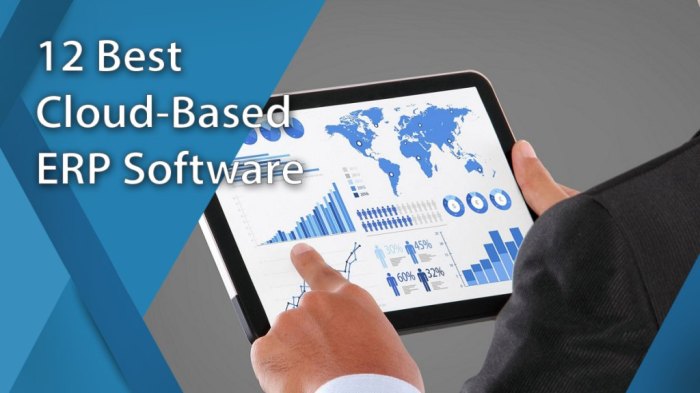
Numerous businesses have achieved significant success by implementing ERP software for cloud computing. These case studies provide valuable insights into the benefits and challenges of such implementations.
One notable case study is that of a global manufacturing company. The company experienced challenges with its legacy ERP system, including outdated technology, limited scalability, and poor data integration. By migrating to a cloud-based ERP solution, the company was able to improve efficiency, reduce costs, and gain real-time visibility into its operations.
Benefits Achieved
- Improved operational efficiency and productivity
- Reduced IT costs and maintenance expenses
- Enhanced data security and compliance
- Increased agility and scalability
- Improved customer satisfaction and loyalty
Challenges Faced
- Data migration and integration complexities
- Change management and employee training
- Security concerns and regulatory compliance
- Integration with legacy systems and third-party applications
- Cost of implementation and ongoing maintenance
Despite these challenges, the company successfully overcame these obstacles and realized significant benefits from its cloud-based ERP implementation. This case study demonstrates the potential of ERP software for cloud computing to transform business operations and drive success.
10. Trends and Future of ERP Software for Cloud Computing
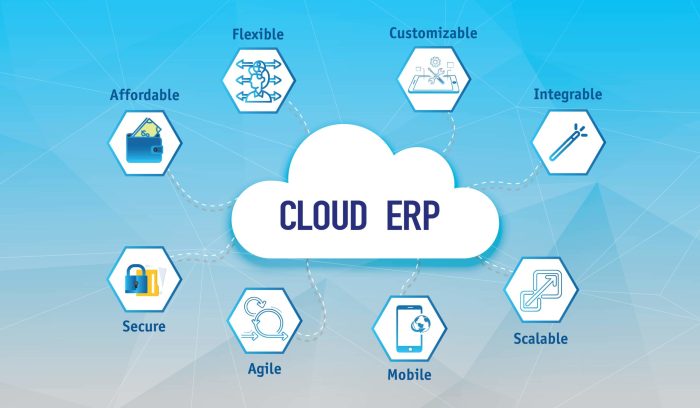
The ERP software for cloud computing is rapidly evolving, with new trends emerging that are shaping the future of this technology. These trends include the increasing adoption of artificial intelligence (AI) and machine learning (ML), the growing popularity of cloud-native ERP solutions, and the rise of industry-specific ERP applications.
AI and ML are being used to automate tasks, improve decision-making, and provide real-time insights. Cloud-native ERP solutions are designed specifically for the cloud, offering greater scalability, flexibility, and cost-effectiveness. Industry-specific ERP applications are tailored to the unique needs of specific industries, providing specialized functionality and best practices.
Future Direction of ERP Software for Cloud Computing
- Continued growth in adoption:ERP software for cloud computing is expected to continue to grow in popularity as businesses realize the benefits of cloud computing.
- Increased use of AI and ML:AI and ML will play an increasingly important role in ERP software, automating tasks, improving decision-making, and providing real-time insights.
- Greater focus on industry-specific solutions:ERP vendors will continue to develop industry-specific solutions that are tailored to the unique needs of specific industries.
- Improved integration with other systems:ERP software will become more tightly integrated with other business systems, such as CRM, SCM, and HCM.
- Enhanced security and compliance:ERP vendors will continue to invest in security and compliance measures to protect customer data.
Best Practices for Using ERP Software for Cloud Computing
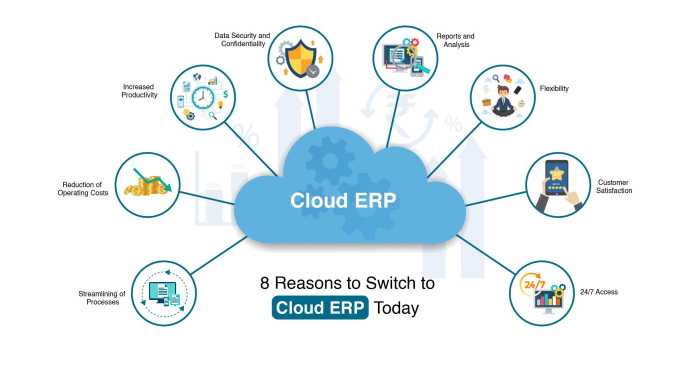
Adopting best practices for using ERP software for cloud computing can maximize its benefits and mitigate potential risks. These practices encompass optimizing performance, enhancing security, and ensuring a high return on investment (ROI).
Performance Optimization
- Choose a reliable cloud provider:Select a provider with a proven track record of uptime, performance, and security.
- Optimize data storage and retrieval:Use cloud storage options that align with your data access patterns, such as object storage for unstructured data and relational databases for structured data.
- Utilize caching and load balancing:Implement caching mechanisms to reduce database load and improve response times. Use load balancers to distribute traffic across multiple servers, ensuring scalability and high availability.
Security Enhancement
- Implement multi-factor authentication:Require users to provide multiple forms of identification, such as a password and a security token, to access the ERP system.
- Enforce data encryption:Encrypt data both at rest and in transit to protect it from unauthorized access.
- Regularly perform security audits:Conduct periodic security audits to identify and address vulnerabilities in the ERP system and cloud infrastructure.
Maximizing ROI, ERP software for cloud computing
- Align ERP implementation with business goals:Clearly define the business objectives that the ERP system is intended to support and ensure that its implementation is aligned with those goals.
- Measure and track key performance indicators (KPIs):Establish relevant KPIs to monitor the performance of the ERP system and its impact on business outcomes.
- Continuously optimize and improve:Regularly review the ERP system’s performance and identify areas for improvement. Implement upgrades and enhancements as needed to maintain optimal performance and ROI.
Last Recap
In conclusion, ERP software for cloud computing is an indispensable tool for businesses seeking to optimize their operations and gain a competitive edge. By embracing this transformative technology, organizations can unlock a world of possibilities, from streamlined processes to enhanced collaboration and data-driven decision-making.
The future of ERP software for cloud computing holds even greater promise, with continuous advancements and innovations promising to further revolutionize the way businesses operate.
FAQ Section
What are the key benefits of using ERP software for cloud computing?
ERP software for cloud computing offers numerous benefits, including cost savings, improved efficiency, enhanced collaboration, and increased flexibility.
How does ERP software for cloud computing help businesses save costs?
Cloud-based ERP systems eliminate the need for expensive on-premise hardware and IT infrastructure, resulting in significant cost savings.
What are the security considerations for ERP software for cloud computing?
ERP software for cloud computing providers implement robust security measures, including data encryption, access control, and disaster recovery plans, to ensure the confidentiality and integrity of data.